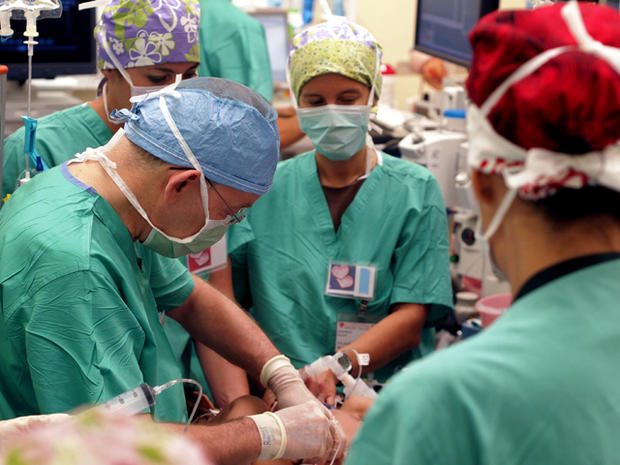Conjoined twins undergo separation surgery in Calif.
(CBS/AP) Surgery to separate conjoined twins Angelica and Angelina Sabuco got under way Tuesday morning at a hospital in Northern California.
PICTURES: Conjoined twins Angelica and Angelina Sabuco
The complicated operation to separate the two-year-olds began at 6:30 a.m. local time at Stanford University's Lucile Packard Children's Hospital in Palo Alto. If things go according to plan, the Philippines-born girls will be out of surgery by mid-afternoon, hospital spokeswoman Reena Mukamal said.
The operation will involve cutting along the girls' skin and muscle and separating their diaphragms and livers. Dividing the liver will be the riskiest part of the procedure because of potential blood loss, said Dr. Gary Hartman, the lead surgeon.
Hartman has done five separation procedures at medical centers around the U.S. He said he expects the operation to go well.
Keeping the girls joined carries big risks for their health, doctors said. If one conjoined twin dies, the other will die within hours. Muscular and skeletal deformities can also worsen with time.
"We want them to live normally," said Ginady Sabuco, the girls' mother. "When they argue, they can be alone. When they play, they can play together or apart. When they don't want to see each other, they won't have to."
Angelica and Angelina are classified as thoraco-omphalopagustwins - joined at the chest and abdomen. Their livers, diaphragms, breastbones, chest and abdominal wall muscles are fused. They have separate hearts, brains, kidneys, stomachs, and intestines.
Though unlikely to need intense physical therapy after surgery, the girls may experience regression with some milestones they've already hit, Hartman said. For example, the girls can walk now despite their face-to-face orientation but may lose that ability for a few weeks to months while they recover. They were expected to be in the hospital for two to three weeks.
The girls live in San Jose, Calif. with their parents and 10-year-old brother.
Conjoined twins occur in about one of every 200,000 live births, according to the website of the University of Maryland Medical Center. Forty percent to 60 percent of conjoined twins are stillborn, and about 35 percent survive only one day. But girls seem to have a better shot at survival than boys.
